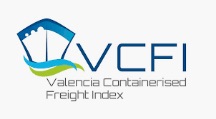The VCFI is the index created by the Port Authority of Valencia to reflect the evolution of the market rates for the export of full containers by sea from Valenciaport. VCFI stands for Valencia Containerised Freight Index. This index will serve shippers as a tool to predict the evolution of freight rates within their markets of interest, which is a key determinant of the cost of their export operations. On the other hand, it will also be useful for operators that offer such services, providing a benchmark for the evolution of their own freight rates and those on the market.
VCFI General
VCFI March 2025
In March 2025, the Valencia Containerised Freight Index (VCFI) recorded a drop of -5.18% compared to the previous month, reaching 2,050.86 points. Despite this monthly drop, the index maintains a remarkable cumulative growth of 105.09% since its inception in 2018. By way of benchmarking, the Shanghai Containerized Freight Index (SCFI) also recorded declines during March, with a 2.02% drop in the third week alone.
Turning to the VCFI analysis, and with respect to the regional sub-indexes, the one for the Western Mediterranean suffered a -13.48% decrease, standing at 2,254.75 points, although it still has a cumulative increase of 125.48% since 2018. The Far East sub-index also experienced a decrease of -7.26%, with a value of 2,124.99 points and a cumulative growth of 112.50% since the beginning of the series.
As far as global trade is concerned, the World Trade Organization’s (WTO) Trade in Goods Barometer shows moderate growth in world trade, with an index of 102.8, indicating that goods are above trend. This value reflects growth in global trade, but is not necessarily immediately reflected in freight rates. The declines in the VCFI and SCFI are due to factors specific to the freight sector, such as overcapacity on some routes and post-holiday adjustments, which have reduced trade activity in certain areas. In this sense, freight dynamics respond to a series of additional factors, such as the adjustment in fleet capacities and geopolitical uncertainty, which could be generating fluctuations in shipping prices.
In the same context, the latest RWI/ISL Index reading suggests an upturn in global trade, with an increase in container throughput. However, European ports experienced a slight drop after the previous month’s strong increase. Despite this, the threat of new tariffs from the U.S. government could drive an anticipated increase in imports, which in turn could reduce demand in the future.
On the shipping supply side, according to Alphaliner data, the inactive containership fleet remained stable in March 2025, representing approximately 0.7% of the global fleet. As of March 11, there were 73 idle vessels, totaling 187,755 TEUs, indicating a slight decrease in idle capacity compared to February. This stability suggests that the industry continues to operate close to full capacity, despite fluctuations in demand and geopolitical tensions.
Regarding the energy and commodities market, the price of Brent crude oil recorded a 4.88% decrease, from US$75.44 per barrel in February to US$71.76 in March. In the marine fuels sector, a downward trend was also observed, with the price of VLSFO (Very Low Sulphur Fuel Oil) in the 20 main world ports falling to US$551.50 in March, reflecting the decrease in energy costs and the volatility of the global market.
In this context, logistics operators are adjusting their strategies to cope with market volatility. Although the downward trend in freight rates in March is partly due to seasonal factors, it could also signal a period of readjustment in global trade in the face of economic uncertainty. For the time being, all indications are that this uncertainty stemming from the threat of new tariffs from the US has not had an immediate impact on freight rates, which continued to show a downward trend in March. However, in the coming months, there could be fluctuations in rates, depending on the evolution of demand and international trade policies.
VCFI Participating Companies

















